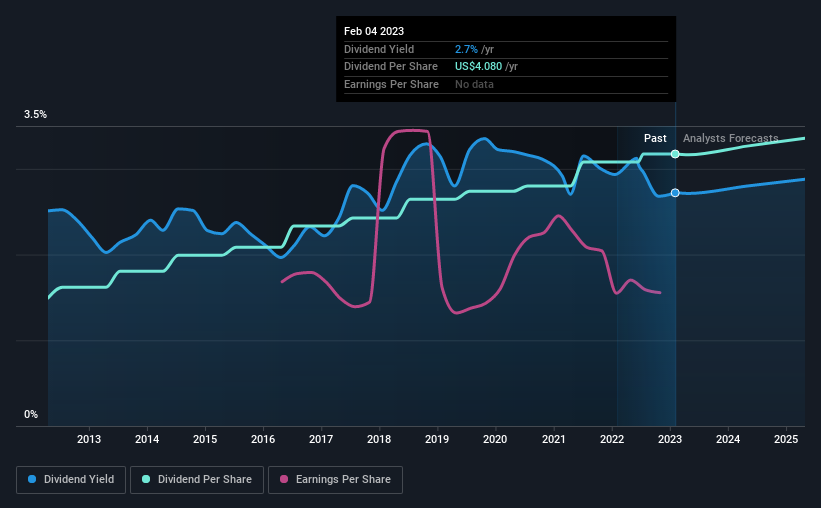Should Income Investors Look At The J. M. Smucker Company (NYSE:SJM) Before Its Ex-Dividend?
It looks like The J. M. Smucker Company (NYSE:SJM) is about to go ex-dividend in the next four days. The ex-dividend date is one business day before the record date, which is the cut-off date for shareholders to be present on the company's books to be eligible for a dividend payment. The ex-dividend date is of consequence because whenever a stock is bought or sold, the trade takes at least two business day to settle. This means that investors who purchase J. M. Smucker's shares on or after the 9th of February will not receive the dividend, which will be paid on the 1st of March.
The company's upcoming dividend is US$1.02 a share, following on from the last 12 months, when the company distributed a total of US$4.08 per share to shareholders. Looking at the last 12 months of distributions, J. M. Smucker has a trailing yield of approximately 2.7% on its current stock price of $149.97. We love seeing companies pay a dividend, but it's also important to be sure that laying the golden eggs isn't going to kill our golden goose! That's why we should always check whether the dividend payments appear sustainable, and if the company is growing.
Check out our latest analysis for J. M. Smucker
Dividends are typically paid from company earnings. If a company pays more in dividends than it earned in profit, then the dividend could be unsustainable. Its dividend payout ratio is 75% of profit, which means the company is paying out a majority of its earnings. The relatively limited profit reinvestment could slow the rate of future earnings growth. We'd be worried about the risk of a drop in earnings. Yet cash flows are even more important than profits for assessing a dividend, so we need to see if the company generated enough cash to pay its distribution. It paid out 82% of its free cash flow as dividends, which is within usual limits but will limit the company's ability to lift the dividend if there's no growth.
It's encouraging to see that the dividend is covered by both profit and cash flow. This generally suggests the dividend is sustainable, as long as earnings don't drop precipitously.
Click here to see the company's payout ratio, plus analyst estimates of its future dividends.
Have Earnings And Dividends Been Growing?
Companies that aren't growing their earnings can still be valuable, but it is even more important to assess the sustainability of the dividend if it looks like the company will struggle to grow. If earnings decline and the company is forced to cut its dividend, investors could watch the value of their investment go up in smoke. With that in mind, we're not enthused to see that J. M. Smucker's earnings per share have remained effectively flat over the past five years. It's better than seeing them drop, certainly, but over the long term, all of the best dividend stocks are able to meaningfully grow their earnings per share. A payout ratio of 75% looks like a tacit signal from management that reinvestment opportunities in the business are low. In line with limited earnings growth in recent years, this is not the most appealing combination.
Another key way to measure a company's dividend prospects is by measuring its historical rate of dividend growth. J. M. Smucker has delivered an average of 7.8% per year annual increase in its dividend, based on the past 10 years of dividend payments.
To Sum It Up
From a dividend perspective, should investors buy or avoid J. M. Smucker? J. M. Smucker has struggled to grow its earnings per share, and while the company is paying out a majority of its earnings and cash flow in the form of dividends, the dividend payments don't appear unsustainable. Overall, it's hard to get excited about J. M. Smucker from a dividend perspective.
If you're not too concerned about J. M. Smucker's ability to pay dividends, you should still be mindful of some of the other risks that this business faces. To help with this, we've discovered 1 warning sign for J. M. Smucker that you should be aware of before investing in their shares.
If you're in the market for strong dividend payers, we recommend checking our selection of top dividend stocks.
Have feedback on this article? Concerned about the content? Get in touch with us directly. Alternatively, email editorial-team (at) simplywallst.com.
This article by Simply Wall St is general in nature. We provide commentary based on historical data and analyst forecasts only using an unbiased methodology and our articles are not intended to be financial advice. It does not constitute a recommendation to buy or sell any stock, and does not take account of your objectives, or your financial situation. We aim to bring you long-term focused analysis driven by fundamental data. Note that our analysis may not factor in the latest price-sensitive company announcements or qualitative material. Simply Wall St has no position in any stocks mentioned.
Join A Paid User Research Session
You’ll receive a US$30 Amazon Gift card for 1 hour of your time while helping us build better investing tools for the individual investors like yourself. Sign up here

 Yahoo Finance
Yahoo Finance 
